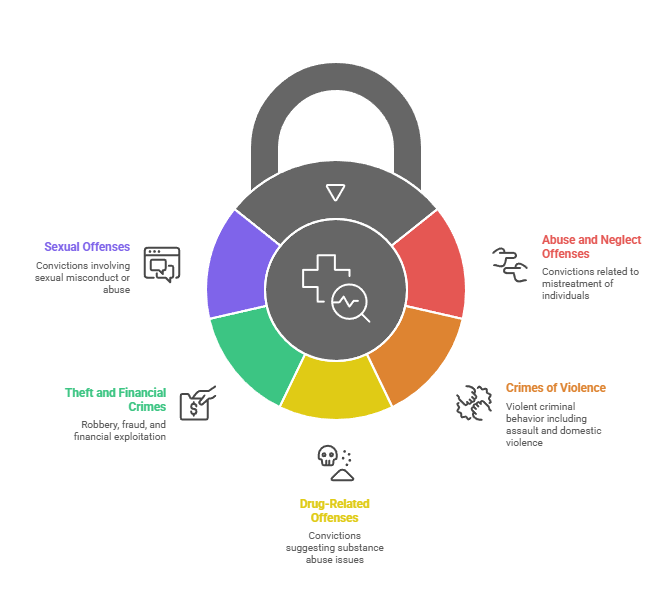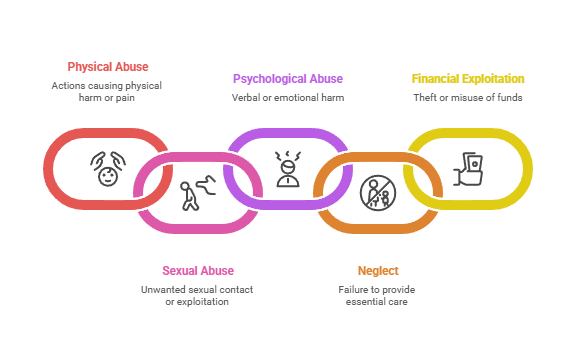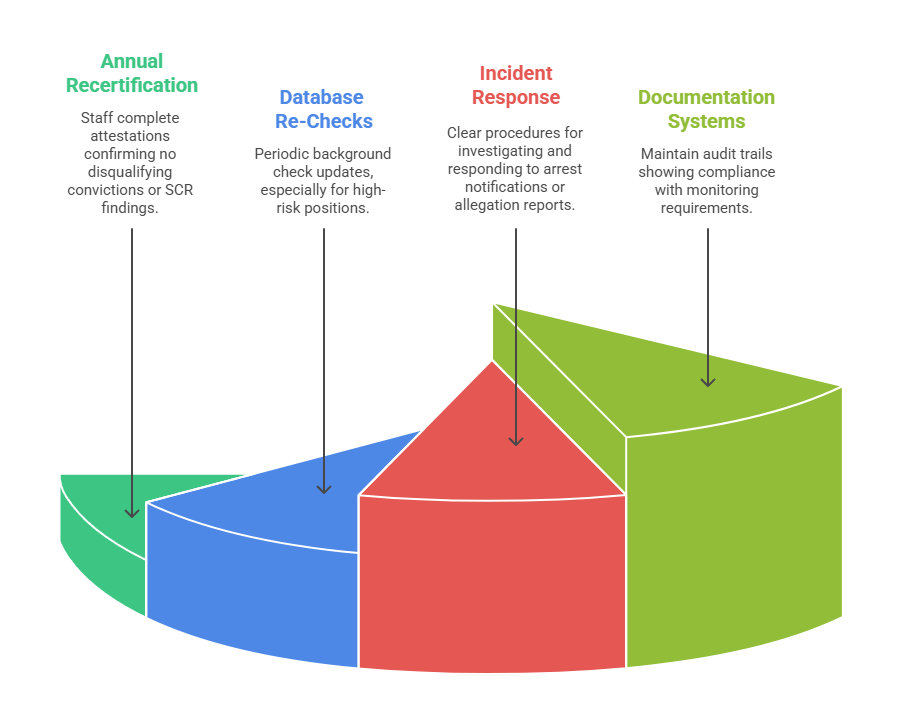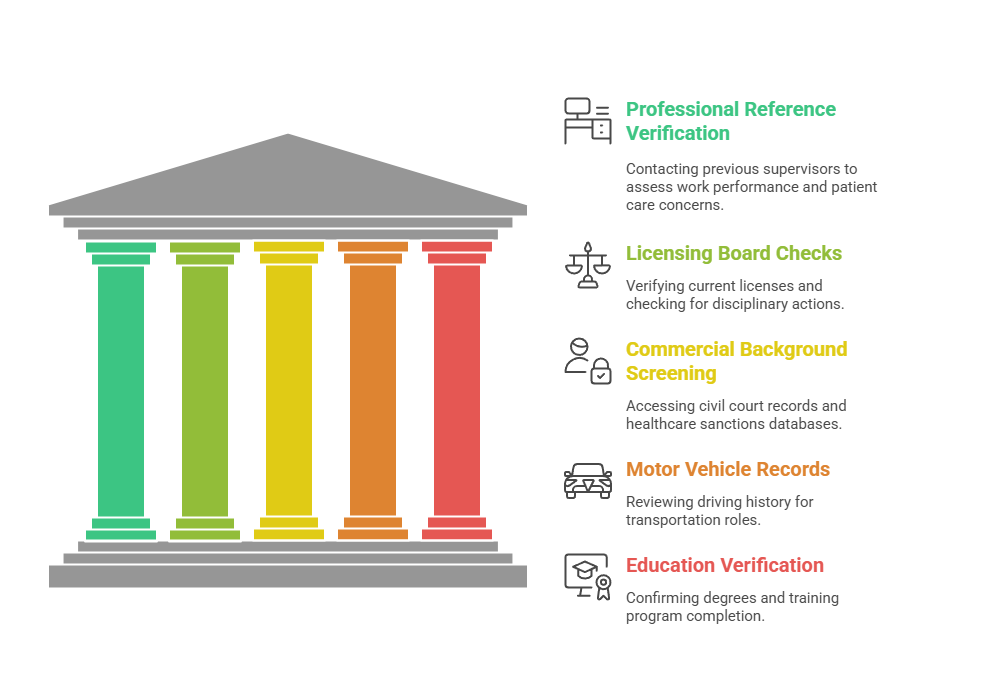New York nursing home facilities must navigate one of the nation's most stringent background check systems, requiring dual clearance through both the Department of Health (DOH) and the Justice Center for the Protection of People with Special Needs. Administrators who fail to complete comprehensive background investigations risk substantial penalties, license suspensions, and exposure to vulnerable person abuse claims that can devastate facility reputation and operational viability.
Key Takeaways
- New York nursing homes must obtain Justice Center clearance for all staff working with vulnerable persons, in addition to standard DOH background checks, creating a dual-agency compliance requirement.
- The State Central Register (SCR) database maintains records of substantiated abuse allegations, and hiring someone listed can result in civil penalties up to $10,000 per violation and potential license revocation.
- Fingerprint-based criminal background checks are mandatory for nursing aides, with FBI and New York State criminal history review required before direct patient contact.
- Justice Center background investigations typically take 3-5 business days but can extend to 30+ days if potential database matches require adjudication.
- New York's vulnerable persons registry includes perpetrators of abuse, neglect, and mistreatment in healthcare settings, and must be checked for all clinical and direct-care positions.
- Nursing home administrators face personal liability under New York Public Health Law if they knowingly employ individuals with disqualifying convictions or substantiated abuse findings.
- Healthcare background screening compliance requires continuous monitoring, as New York mandates re-screening whenever staff transfer between facilities or change job responsibilities.
- The nursing aide certification process includes both background clearance and training verification through the New York State Nurse Aide Registry, with renewals every 24 months.
Understanding New York's Dual-Agency Background Check System
New York operates a uniquely complex regulatory framework for nursing home employee screening. Unlike most states with single-agency oversight, New York requires nursing home administrators to navigate requirements from two distinct government entities. These are the Department of Health (DOH) and the Justice Center for the Protection of People with Special Needs.
This dual-jurisdiction system emerged from legislative reforms following high-profile cases of vulnerable person abuse in residential care settings. The Justice Center, established in 2013, functions as an independent oversight body specifically focused on preventing mistreatment of individuals receiving care in certified settings. Meanwhile, the DOH maintains its traditional healthcare facility licensing authority, including background check mandates for specific healthcare positions.
New York nursing home background check requirements now represent the most comprehensive screening framework in the United States. Administrators must understand how both agencies' requirements interact to ensure full compliance. This complexity demands specialized expertise and proactive planning to avoid costly delays and regulatory violations.
Department of Health Background Check Requirements
The New York State Department of Health mandates criminal background checks for all certified nursing assistants (CNAs) and other direct-care personnel in nursing homes. This requirement flows from federal regulations under the Omnibus Budget Reconciliation Act (OBRA) and corresponding state public health laws. DOH background investigations create the first layer of employee screening protection.
DOH screening examines specific categories of criminal history that indicate unsuitability for vulnerable person care:

- Abuse and Neglect Offenses: Convictions related to abuse, neglect, or mistreatment of individuals in any setting.
- Crimes of Violence: Assault, battery, domestic violence, and other violent criminal behavior.
- Drug-Related Offenses: Manufacturing, distribution, or possession convictions that suggest substance abuse issues.
- Theft and Financial Crimes: Robbery, burglary, fraud, identity theft, and financial exploitation.
- Sexual Offenses: Any conviction involving sexual misconduct, harassment, or abuse.
Certain convictions create automatic disqualification, while others trigger case-by-case review. The DOH considers factors such as time elapsed since conviction, rehabilitation evidence, and the nature of the offense relative to job responsibilities.
Justice Center Clearance Requirements
The Justice Center clearance process represents the more comprehensive component of New York nursing home background check requirements. All staff members who will have the potential for regular and substantial contact with vulnerable persons must receive Justice Center authorization before beginning employment. This clearance provides real-time protection against individuals with documented histories of resident mistreatment.
Justice Center background investigations extend beyond criminal convictions to capture administrative findings and regulatory violations. An individual may have no criminal record yet appear in SCR databases due to substantiated workplace conduct violations. These can include licensing board actions or terminations related to patient safety concerns.
How the Two Systems Interact
Nursing home administrators must satisfy both DOH and Justice Center requirements concurrently—one clearance does not substitute for the other. A candidate might pass the DOH criminal background check but fail Justice Center screening due to an SCR listing. The reverse situation can also occur.
| Clearance Type | Primary Focus | Processing Time | Scope of Staff |
| DOH Background Check | Criminal history via fingerprints | 2-3 weeks | CNAs and direct-care clinical staff |
| Justice Center Clearance | SCR database and abuse findings | 3-5 days (standard) | All staff with vulnerable person contact |
Only when both clearances are obtained can an individual legally work in direct-care capacity. Different timelines, separate fingerprinting requirements, and distinct appeals processes mean HR directors must manage parallel workflows for each new hire.
The Justice Center Background Investigation Process
Understanding the Justice Center background investigation workflow is critical for maintaining hiring efficiency while ensuring compliance. The process involves multiple verification points and can trigger unexpected delays if administrators aren't familiar with its nuances. The investigation begins when the facility submits a background check request through the Justice Center's online portal.
Administrators must provide the applicant's full legal name, date of birth, Social Security number, and employment history for the past five years. The Justice Center cross-references this information against multiple databases. These include the SCR, professional licensing boards, and healthcare facility incident reports.
Typical Processing Timeline
Standard Justice Center background investigations take between 3-5 business days when no database matches occur. However, conditional or provisional clearances extend this timeframe significantly. If the system identifies a potential match—even based on similar names or birthdates—the Justice Center initiates an adjudication process.
During adjudication, applicants must submit fingerprints, notarized identity affidavits, and detailed explanations of any prior employment separations. This adjudication phase can extend to 30-45 days. Such delays create workforce planning challenges for facilities needing immediate staffing coverage.
Provisional Employment Options
New York regulations permit provisional employment under limited circumstances while background investigations remain pending. Facilities may allow an individual to work under direct, continuous supervision of a fully cleared employee for up to 90 days. This option provides operational flexibility but carries significant compliance risks.
The supervising employee must maintain constant visual contact with the provisionally employed individual during all resident interactions. This supervision requirement creates operational burdens, pulling experienced staff from their regular duties. Additionally, it limits scheduling flexibility and increases labor costs substantially.
New York State Vulnerable Persons Registry and SCR Database
The State Central Register represents the cornerstone of New York's vulnerable person protection system. This confidential database contains detailed records of abuse, neglect, and mistreatment allegations investigated by the Justice Center since its inception in 2013. SCR entries create permanent employment barriers for individuals found responsible for vulnerable person mistreatment.
SCR entries include the alleged perpetrator's identifying information, the nature of allegations, investigation findings, and final determinations. Substantiated reports remain in the registry indefinitely. Even unsubstantiated reports remain accessible during the investigation period and for limited timeframes thereafter.
The Justice Center maintains strict confidentiality around SCR records, releasing information only for authorized employment screening purposes. Unauthorized access or disclosure of SCR information carries criminal penalties. Administrators must ensure their background check procedures include appropriate confidentiality safeguards and limited-access protocols.
What Triggers an SCR Listing
SCR listings result from formal investigations into allegations of abuse, neglect, obstruction of reporting, or retaliation against individuals who report concerns. These investigations can originate from facility incident reports, family complaints, or anonymous hotline calls. Healthcare surveyors may also initiate investigations during routine inspections.
The following categories of conduct generate SCR investigations and potential listings:

- Physical Abuse: Hitting, slapping, pushing, inappropriate restraint use, or force causing injury or pain.
- Sexual Abuse: Any unwanted sexual contact, comments, exposure, or exploitation of vulnerable persons.
- Psychological Abuse: Verbal harassment, threats, humiliation, intimidation, or emotional manipulation.
- Neglect: Failure to provide necessary food, clothing, shelter, medical care, hygiene assistance, or supervision.
- Financial Exploitation: Theft, unauthorized use of funds, coercion regarding financial decisions, or property misappropriation.
Even a single substantiated incident creates a permanent SCR listing. This permanence reflects New York's policy prioritization of vulnerable person safety over workforce reintegration.
Record Retention Timelines
| Finding Type | Retention Period | Employment Impact |
| Substantiated Abuse | Permanent | Automatic disqualification from vulnerable person contact |
| Unsubstantiated Finding | 3 years | May be considered for pattern analysis in subsequent investigations |
| Pending Investigation | Until resolution | Clearance typically denied until final determination |
Pending investigations appear in real-time SCR searches until final determination. If an applicant has an investigation underway during background screening, the Justice Center typically denies clearance until investigation resolution. This creates challenging situations where otherwise qualified candidates face indefinite hiring delays.
Healthcare Background Screening Compliance Requirements

Comprehensive healthcare background screening compliance extends beyond initial hire investigations. New York regulations mandate ongoing monitoring, re-screening under specific circumstances, and documentation retention protocols. Administrators must integrate these requirements into standard HR operations to maintain continuous compliance.
Facilities must maintain complete background check files for all staff. Documentation must include clearance dates, any conditional restrictions, provisional employment periods, and supervision logs. These records face routine inspection during DOH surveys and Justice Center audits.
Continuous Monitoring Obligations
New York nursing home administrators bear responsibility for continuous awareness of staff criminal convictions and SCR listings that occur post-hire. Employees must self-report arrests, pending criminal charges, and involvement in Justice Center investigations within 24 hours of occurrence. Facilities should implement written policies requiring these disclosures and outlining consequences for non-reporting.
Best practices for ongoing monitoring include several key elements:

- Annual Recertification: Require all staff to complete annual attestations confirming no disqualifying convictions or SCR findings.
- Database Re-Checks: Conduct periodic background check updates, particularly for high-risk positions involving medication administration or financial access.
- Incident Response Protocols: Establish clear procedures for investigating and responding to arrest notifications or allegation reports.
- Documentation Systems: Maintain audit trails showing compliance with monitoring requirements and timely responses to concerning information.
When an employee receives a post-hire criminal conviction or substantiated SCR finding, administrators must immediately remove the individual from direct-care duties pending review. Depending on the offense nature and position requirements, termination may be mandatory rather than discretionary.
Re-screening Trigger Events
New York mandates background check re-screening whenever an employee transfers between certified healthcare facilities, even within the same corporate system. A nurse moving from one nursing home to another owned by the same entity requires complete Justice Center clearance and DOH background check renewal. Each facility holds separate licensure, necessitating independent verification of staff clearances.
Job position changes within the same facility may also trigger re-screening requirements. An employee moving from a non-direct-care role into a clinical position requires updated background investigations reflecting the increased vulnerable person contact level. Similarly, promotions into supervisory roles overseeing direct-care staff may necessitate enhanced screening protocols.
Nursing Aide Certification and Registry Requirements
Nursing aide certification represents a distinct regulatory layer within New York nursing home background check requirements. Federal and state laws mandate that all nursing assistants providing hands-on resident care maintain active certification through the New York State Nurse Aide Registry. This certification integrates with but operates separately from Justice Center clearances.
Certification eligibility requires completing state-approved training programs, passing competency evaluations, and maintaining clear background check status. The certification process creates additional verification obligations for administrators beyond standard Justice Center and DOH clearances. Understanding these layered requirements prevents compliance gaps that can result in survey citations.
Initial Certification Background Checks
Nursing aide training programs conduct preliminary background checks before accepting students. These pre-training screenings prevent individuals with disqualifying convictions from investing time and money in training they cannot use professionally. Upon training completion, certification applicants undergo comprehensive criminal background checks including fingerprint-based FBI and state criminal history reviews.
Certain convictions permanently bar nursing aide certification:
- Violent Crimes: Murder, manslaughter, assault resulting in serious bodily injury, or kidnapping.
- Sexual Offenses: Any conviction involving sexual abuse, exploitation, or assault.
- Vulnerable Person Crimes: Abuse, neglect, or exploitation of children, elderly persons, or disabled individuals.
- Serious Theft: Robbery, burglary involving occupied dwellings, or identity theft schemes.
Other convictions may allow certification after review periods ranging from 5-15 years depending on offense severity. The New York State Department of Health makes final determinations on certification eligibility based on conviction review.
Registry Maintenance Requirements
The New York State Nurse Aide Registry maintains records of all certified nursing assistants. This includes certification dates, training program information, and any substantiated findings of resident abuse or neglect. Employers must verify current registry status before allowing nursing assistants to provide care and periodically throughout employment.
Certifications remain active for 24 months, requiring renewal through documented work hours or refresher training. Nursing assistants must work at least 8 hours providing nursing-related services for compensation during each renewal period. Employers verify these hours through registry submissions, creating ongoing administrative responsibilities for HR departments.
Risk Mitigation Strategies for Nursing Home Administrators
Effective background screening compliance requires more than simply processing required checks. Forward-thinking administrators implement comprehensive risk mitigation strategies that exceed minimum regulatory requirements. These proactive approaches protect facilities from liability exposure and operational disruptions that can arise from inadequate screening.
A compliance-first approach begins with robust written policies establishing clear background check procedures, escalation protocols for problematic findings, and staff responsibilities for ongoing monitoring. These policies should receive annual legal review to ensure alignment with evolving Justice Center guidance and DOH regulations. Additionally, regular compliance training for HR staff, hiring managers, and department supervisors reinforces organizational commitment to thorough screening.
Implementing Layered Screening Protocols
Leading nursing home facilities implement layered screening protocols combining Justice Center clearances, DOH background checks, and additional verification sources. This multi-source approach identifies concerns that might escape detection through single-source screening. Comprehensive screening creates stronger liability protection and demonstrates due diligence during litigation or regulatory investigations.
Enhanced screening components supplement mandatory government checks:

- Professional Reference Verification: Contact at least three previous supervisors to discuss work performance, attendance, and any patient care concerns.
- Licensing Board Checks: Verify all professional licenses are current and check for disciplinary actions or restrictions.
- Commercial Background Screening: Access civil court records, national healthcare sanctions databases, and sex offender registries.
- Motor Vehicle Records: Review driving history for positions involving resident transportation responsibilities.
- Education Verification: Confirm claimed degrees, certifications, and training program completion directly with issuing institutions.
Social media screening has emerged as a controversial but increasingly common practice. While requiring careful implementation to avoid discrimination claims, structured social media review can identify publicly posted content suggesting poor judgment or substance abuse issues. Facilities using social media screening should implement written protocols ensuring consistent, non-discriminatory application.
Building Compliance Documentation Systems
Comprehensive documentation systems protect facilities during regulatory surveys and potential litigation. Every background check file should contain chronological logs showing exactly when clearances were requested, received, and verified before the employee began work. Missing documentation creates presumptions of non-compliance that burden administrators during enforcement proceedings.
Digital document management systems with automated reminders help track certification expirations, clearance renewal deadlines, and re-screening trigger events. These systems prevent situations where employees work beyond valid clearance periods due to administrative oversights. Such preventable violations represent a common citation source during inspections.
Conclusion
New York nursing home background check requirements represent among the nation's most comprehensive healthcare screening mandates. These dual-agency clearance processes reflect the state's commitment to vulnerable person protection. Administrators who master Justice Center clearances, SCR database monitoring, and nursing aide certification requirements position their facilities to avoid costly penalties while building trustworthy workforces. Comprehensive compliance demands specialized expertise, meticulous documentation, and continuous regulatory awareness that internal HR departments often struggle to maintain consistently.
Frequently Asked Questions
How long does a New York nursing home background check take?
Standard Justice Center background investigations typically take 3-5 business days when no database matches occur. However, if potential matches require adjudication, the process can extend to 30-45 days. DOH criminal background checks usually complete within 2-3 weeks after fingerprint submission. Administrators should plan for 4-6 weeks total when both clearances must be obtained simultaneously.
Can nursing homes hire employees with criminal records in New York?
New York law prohibits nursing homes from hiring individuals with certain convictions including abuse, neglect, assault, sexual offenses, and crimes against vulnerable persons. Other convictions require case-by-case review considering factors such as time since conviction, rehabilitation evidence, and offense relevance to job duties. The Justice Center makes final determinations on whether specific criminal histories disqualify candidates. Some positions may permit employment after review periods ranging from 5-15 years depending on conviction severity.
What is the difference between DOH and Justice Center background checks?
DOH background checks focus on criminal history through fingerprint-based FBI and state database searches, primarily for certified nursing assistants and clinical staff. Justice Center clearances check the State Central Register for abuse allegations and substantiated findings, applying to all staff with potential vulnerable person contact. Both clearances are required, and neither substitutes for the other. The dual-agency system creates comprehensive protection but requires parallel processing workflows.
How much do New York nursing home background checks cost?
Fingerprint processing fees for DOH criminal background checks range from $100-$150 per applicant including FBI and state criminal history review. Justice Center clearance requests cost approximately $50-$75 per applicant. Facilities using third-party screening services typically pay $200-$300 per comprehensive background investigation covering both requirements plus additional verification sources. These costs represent necessary investments in compliance and risk mitigation.
What happens if an employee fails a background check after being hired?
If substantiated abuse findings or disqualifying convictions are discovered post-hire, administrators must immediately remove the employee from direct-care duties. Depending on the offense nature, termination may be mandatory. Facilities face penalties up to $10,000 per violation for employing individuals with disqualifying backgrounds. Employees have appeal rights but typically cannot continue working during appeals processes.
Do volunteers and contractors need Justice Center clearance?
Yes, volunteers and contracted staff who will have regular and substantial contact with residents require Justice Center clearance before beginning work. This includes contracted therapy providers, beauticians, religious counselors, and volunteer activity coordinators. The only exception is for individuals making brief, supervised visits with no unsupervised resident access. Facilities must maintain clearance documentation for all volunteers and contractors just as they do for employees.
How often must nursing home employees be re-screened in New York?
New York requires background check re-screening when employees transfer between facilities, change to positions with increased vulnerable person contact, or return to healthcare work after employment gaps exceeding one year. While annual re-screening isn't mandated, best practices include periodic recertification, particularly for high-risk positions. Employees must also self-report arrests and Justice Center investigations within 24 hours.
Can provisional employment continue if Justice Center clearance is delayed?
Provisional employment may continue up to 90 days under direct, continuous supervision while clearances remain pending. However, supervisors must maintain constant visual contact during all resident interactions, creating significant operational challenges. If clearance isn't resolved within 90 days, provisional employment must end until final authorization is received. Most administrators find provisional employment too resource-intensive for extended periods.
Additional Resources
- New York Justice Center for the Protection of People with Special Needs - Background Checks
https://www.justicecenter.ny.gov/background-checks - New York State Department of Health - Nursing Home Regulations
https://www.health.ny.gov/facilities/nursing/ - New York State Nurse Aide Registry - Certification Verification
https://www.health.ny.gov/professionals/nurse_aide_registry/ - Fair Credit Reporting Act Compliance Guide for Employers
https://www.ftc.gov/business-guidance/resources/using-consumer-reports-what-employers-need-know - CMS State Operations Manual - Background Checks for Long-Term Care Facilities
https://www.cms.gov/Regulations-and-Guidance/Guidance/Manuals/Internet-Only-Manuals-IOMs
